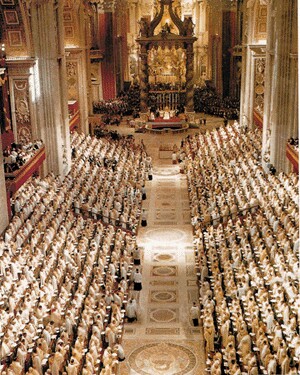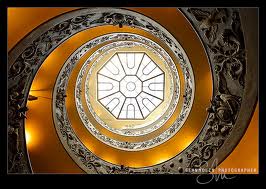
Vatican II took place and was implemented during the tumultuous decade of the counter-culture in the U.S., the Cultural Revolution in China, the end of the Vietnam War, the populist revolution in Peru, Christians for socialism in Chile, and liberation theology in Latin America. The various U.S. renewal movements (civil rights, Women Liberation, and the new religions) have been absorbed after leaving their mark and continue to affect us today. It is in that context that I would interpret the Declaration on religious freedom.
A new paradigm and the problem of authority
"The truth cannot impose itself except by virtue of its own truth." Of course this view "leaves untouched traditional Catholic doctrine on the moral duty of men and societies toward the true religion." (Dignitatis Humanae, # 1). In a monastic church of "submission of mind and will," there is no room for dissent – as on a cruising ship there is no room for mutiny or on the battle field no room for conscientious objectors. Yet the jinnee has been left out of the bottle. Vatican II did not totally legitimize an appeal to conscience, but it came close to the prevailing views of the 1960s, the time of the counter-culture, social activism and the anti-war movement. But if there is no room for dissent in the church, some people will take the liberty of walking out, and for that, no ecclesiastical approval is needed. Hence freedom and the appeal to conscience have divided the church, and there is no return.
I would summarize the legacy of Vatican II in four points.
1. The recognition of the importance of of conscience has produced the most serious crisis of authority in the Catholic Church since the Renaissance. The council reasserted papal infallibility, and at the same time affirmed that, "the infallibility promised to the Church resides also in the body of bishops" (Lumen Gentium, 25), and that, "The entire body of the faithful... cannot err in matters of belief" (ibid. 12). The relationship between the three is not explained; it is up to the individual to reconcile them. The chapter on bishops and collegiality reaffirmed the monarchical authority of the Roman Pontiff who has "full, supreme and universal power over the Church. And he is always free to exercise this power" (ibid. 22). It is also in this chapter on bishops that we find the famous call for "submission of mind and will" (obsequium religiosum) which "must be shown in a special way to the authentic magisterium of the Roman Pontiff, even when he is not speaking ex cathedra" (ibid. 25). There is no room here for a truth that "cannot impose itself except by virtue of its own truth," but we live an cultural environment that puts premium on conscience; this is an explosive mix. Again it is up to the individual conscience to reconcile opposites, which ultimately leads to a crisis of authority.
 2. The consequence is a change of metaphor, from pyramid to circle. In the past the church was seen as a pyramid with a firm top and a solid base, and strong boundaries with the outside world. Today the church is more like a two-dimensional plane with a center but ill-defined boundaries, or like a circle with an undefined periphery, and little connection between the two. The pre-Vatican pyramid was strongly integrated; the post-Vatican II circle has little cohesion as peripheral Catholics are no different from non-Catholics, and mainline Catholics not very different from mainline Protestants. Today the church is split, into two, three, four or as many circles as you would like to draw. For any society cohesion is important because it conditions the transmission of values; cohesion conditions the future. Today the unity of the church is pretty much weakened by a split or tensions between the center and the periphery.
2. The consequence is a change of metaphor, from pyramid to circle. In the past the church was seen as a pyramid with a firm top and a solid base, and strong boundaries with the outside world. Today the church is more like a two-dimensional plane with a center but ill-defined boundaries, or like a circle with an undefined periphery, and little connection between the two. The pre-Vatican pyramid was strongly integrated; the post-Vatican II circle has little cohesion as peripheral Catholics are no different from non-Catholics, and mainline Catholics not very different from mainline Protestants. Today the church is split, into two, three, four or as many circles as you would like to draw. For any society cohesion is important because it conditions the transmission of values; cohesion conditions the future. Today the unity of the church is pretty much weakened by a split or tensions between the center and the periphery.
The emphasis on baptismal commitment and the recovery of "voice"
3. Vatican II also affirmed the primacy of the spirituality of baptism instead of the Tridentine spirituality of frequent confession and communion. It is also a return to the centrality of the kerygma instead of the centrality of ritual and devotions. When baptism came to be applied to infants, it was split into three rituals or sacraments, infant baptism, confirmation, and first communion. Infant baptism does not allow for spiritual rebirth which is the meaning and purpose of baptism. Initiation and mystagogy now take place during the years of catechism in preparation for confirmation and first communion. The three rites have again been united in the Rite of Initiation of Adults. Most people still identify baptism with infant baptism which has become marginal in the lives of many Catholics. Hence the call for a spirituality of baptism happens at a time of sacramental decline; it calls for sacramental renewal.
Central to Vatican II is a call to holiness, that is, a spiritual rebirth through baptism in water and spirit, and a lifelong commitment to the baptismal promises. This applies also to priests and bishops: baptism is not an oath of allegiance to the church but a commitment to Jesus Christ. Any Catholic can remind the hierarchy of this basic commitment, something unheard of in the pre-Vatican II church. Vatican II contains implicitly a new agenda for church life and teaching: the fidelity to one's baptismal commitment through adult education rather than just regular church attendance.
4. The primacy of baptism and the emphasis on conscience have given "voice" to the laity (and also to priests) and led to greater attention to the voice of the Holy Spirit in the sensus fidelium. Since Vatican II there has been a resurgence of prophecy and vision as voice of the Holy Spirit. The study of theology has never been so much alive in the U.S. church, with also multiple pastoral initiatives at the local level. There is even "noise" in the church, for instance about "radical feminism." There was little voice and no noise in the pre-Vatican II church, only magisterial monologue. This trend is quite general in Christianity: there has been a mutual interaction between pentecostalism and evangelicalism, especially in the Third World; sociologists of Latin America speak of the pentecostalization of mainline Protestant churches, and also of the Catholic charismatic movement. When the gifts of the Holy Spirit are emphasized and practiced in churches, there is renewed evangelization, ecumenism, and inner transformation of church structures.
The legacy of Vatican II is clearly with us: 1) in the Catholic authority crisis, 2) the disintegration of Catholic monolithism, 3) the emphasis on baptismal commitment, and 4) the vital role of the Holy Spirit in people and the institutional church.